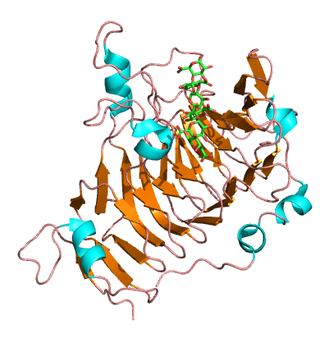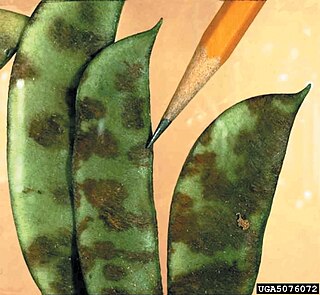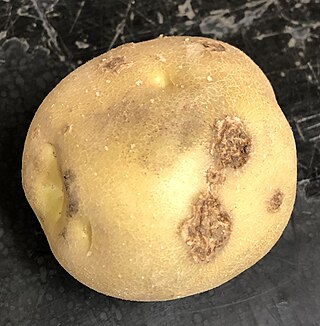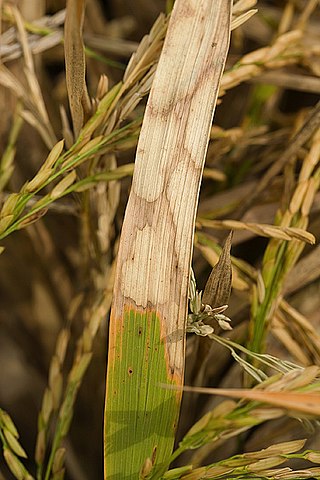
Plant pathology or phytopathology is the scientific study of plant diseases caused by pathogens and environmental conditions. Plant pathology involves the study of pathogen identification, disease etiology, disease cycles, economic impact, plant disease epidemiology, plant disease resistance, how plant diseases affect humans and animals, pathosystem genetics, and management of plant diseases.

Pythium is a genus of parasitic oomycetes. They were formerly classified as fungi. Most species are plant parasites, but Pythium insidiosum is an important pathogen of animals, causing pythiosis. The feet of the fungus gnat are frequently a vector for their transmission.

Dickeya dadantii is a gram-negative bacillus that belongs to the family Pectobacteriaceae. It was formerly known as Erwinia chrysanthemi but was reassigned as Dickeya dadantii in 2005. Members of this family are facultative anaerobes, able to ferment sugars to lactic acid, have nitrate reductase, but lack oxidases. Even though many clinical pathogens are part of the order Enterobacterales, most members of this family are plant pathogens. D. dadantii is a motile, nonsporing, straight rod-shaped cell with rounded ends, much like the other members of the genus, Dickeya. Cells range in size from 0.8 to 3.2 μm by 0.5 to 0.8 μm and are surrounded by numerous flagella (peritrichous).

Trichoderma viride is a fungus and a biofungicide.

Pectinesterase (EC 3.1.1.11; systematic name pectin pectylhydrolase) is a ubiquitous cell-wall-associated enzyme that presents several isoforms that facilitate plant cell wall modification and subsequent breakdown. It catalyzes the following reaction:

Rhizoctonia solani is a species of fungus in the order Cantharellales. Basidiocarps are thin, effused, and web-like, but the fungus is more typically encountered in its anamorphic state, as hyphae and sclerotia. The name Rhizoctonia solani is currently applied to a complex of related species that await further research. In its wide sense, Rhizoctonia solani is a facultative plant pathogen with a wide host range and worldwide distribution. It causes various plant diseases such as root rot, damping off, and wire stem. It can also form mycorrhizal associations with orchids.
Pythium irregulare is a soil borne oomycete plant pathogen. Oomycetes, also known as "water molds", are fungal-like protists. They are fungal-like because of their similar life cycles, but differ in that the resting stage is diploid, they have coenocytic hyphae, a larger genome, cellulose in their cell walls instead of chitin, and contain zoospores and oospores.
Pythium ultimum is a plant pathogen. It causes damping off and root rot diseases of hundreds of diverse plant hosts including corn, soybean, potato, wheat, fir, and many ornamental species. P. ultimum belongs to the peronosporalean lineage of oomycetes, along with other important plant pathogens such as Phytophthora spp. and many genera of downy mildews. P. ultimum is a frequent inhabitant of fields, freshwater ponds, and decomposing vegetation in most areas of the world. Contributing to the widespread distribution and persistence of P. ultimum is its ability to grow saprotrophically in soil and plant residue. This trait is also exhibited by most Pythium spp. but not by the related Phytophthora spp., which can only colonize living plant hosts.

Pectobacterium carotovorum is a bacterium of the family Pectobacteriaceae; it used to be a member of the genus Erwinia.
Pythium dissotocum is a plant pathogen infecting strawberry and rice.
Pythium violae is a plant pathogen infecting carrots. It is a soil-borne oomycete that causes the cavity spot disease of carrots. Pythium sulcatum also causes a less serious form of this disease. Pythium violae causes elliptical shaped brown lesions surrounded by a thin yellow halo on the surface of the taproot. These lesions cause a blemished aesthetic appearance on the carrot, reducing their market value while maintaining yield. The lesions are, on average, less than half an inch in diameter and appear near harvest, but can grow as the carrot matures and grow larger on processing varieties of carrots. Low density hyphae are present in early formation of the lesions, but there is little to no presence of Pythium violae spores in the mature lesions making it difficult to diagnose in the field. This disease can be instigated by excessive rainfall, poor soil drainage, cool temperatures, and low Soil pH. Pythium violae has been shown to infect and produce similar necrotic lesions on other hosts such as alfalfa, wheat, and broccoli. However, no economic loss has been reported from these alternate host infections.

Colletotrichum lindemuthianum is a fungus which causes anthracnose, or black spot disease, of the common bean plant. It is considered a hemibiotrophic pathogen because it spends part of its infection cycle as a biotroph, living off of the host but not harming it, and the other part as a necrotroph, killing and obtaining nutrients from the host tissues.

Pratylenchus penetrans is a species of nematode in the genus Pratylenchus, the lesion nematodes. It occurs in temperate regions worldwide, regions between the subtropics and the polar circles. It is an animal that inhabits the roots of a wide variety of plants and results in necrotic lesions on the roots. Symptoms of P. penetrans make it hard to distinguish from other plant pathogens; only an assay of soil can conclusively diagnose a nematode problem in the field. P. penetrans is physically very similar to other nematode species, but is characterized by its highly distinctive mouthpiece. P. penetrans uses its highly modified mouth organs to rupture the outer surface of subterranean plant root structures. It will then enter into the root interior and feed on the plant tissue inside. P. penetrans is considered to be a crop parasite and farmers will often treat their soil with various pesticides in an attempt to eliminate the damage caused by an infestation. In doing this, farmers will also eliminate many of the beneficial soil fauna, which will lead to an overall degradation of soil quality in the future. Alternative, more environmentally sustainable methods to control P. penetrans populations may be possible in certain regions.
Pectin lyase is a polysaccharide enzyme with a complex structure that is present in plant cell walls. It has a significant role in pectin degradation and different biotechnological and industrial applications. It can be found in different organisms.

Endo-polygalacturonase (EC 3.2.1.15, pectin depolymerase, pectolase, pectin hydrolase, and poly-α-1,4-galacturonide glycanohydrolase; systematic name (1→4)-α-D-galacturonan glycanohydrolase (endo-cleaving)) is an enzyme that hydrolyzes the α-1,4 glycosidic bonds between galacturonic acid residues:

Dickeya solani is a bacterium that causes blackleg and soft rot in potato crops. Its symptoms are often indistinguishable from those caused by Pectobacterium but is more virulent, causing disease from lower levels of inoculum and spreading through the plant more effectively.

Common scab is a plant disease of root and tuber crops caused by a small number of Streptomyces species, specifically S. scabies, S. acidiscabies, S. turgidiscabies and others. Common scab mainly affects potato, but can also cause disease on radish, parsnip, beet, and carrot. This plant disease is found wherever these vegetables are grown.

Alternaria brassicicola is a fungal necrotrophic plant pathogen that causes black spot disease on a wide range of hosts, particularly in the genus of Brassica, including a number of economically important crops such as cabbage, Chinese cabbage, cauliflower, oilseeds, broccoli and canola. Although mainly known as a significant plant pathogen, it also contributes to various respiratory allergic conditions such as asthma and rhinoconjunctivitis. Despite the presence of mating genes, no sexual reproductive stage has been reported for this fungus. In terms of geography, it is most likely to be found in tropical and sub-tropical regions, but also in places with high rain and humidity such as Poland. It has also been found in Taiwan and Israel. Its main mode of propagation is vegetative. The resulting conidia reside in the soil, air and water. These spores are extremely resilient and can overwinter on crop debris and overwintering herbaceous plants.
Black rot on orchids is caused by Pythium and Phytophthora species. Black rot targets a variety of orchids but Cattleya orchids are especially susceptible. Pythium ultimum and Phytophthora cactorum are known to cause black rot in orchids.

Rice-sheath blight is a disease caused by Rhizoctonia solani, a basidiomycete, that causes major limitations on rice production in India and other countries of Asia. It is also a problem in the southern US, where rice is also produced. It can decrease yield up to 50%, and reduce its quality. It causes lesions on the rice plant, and can also cause pre- and post-emergence seedling blight, banded leaf blight, panicle infection and spotted seed.














